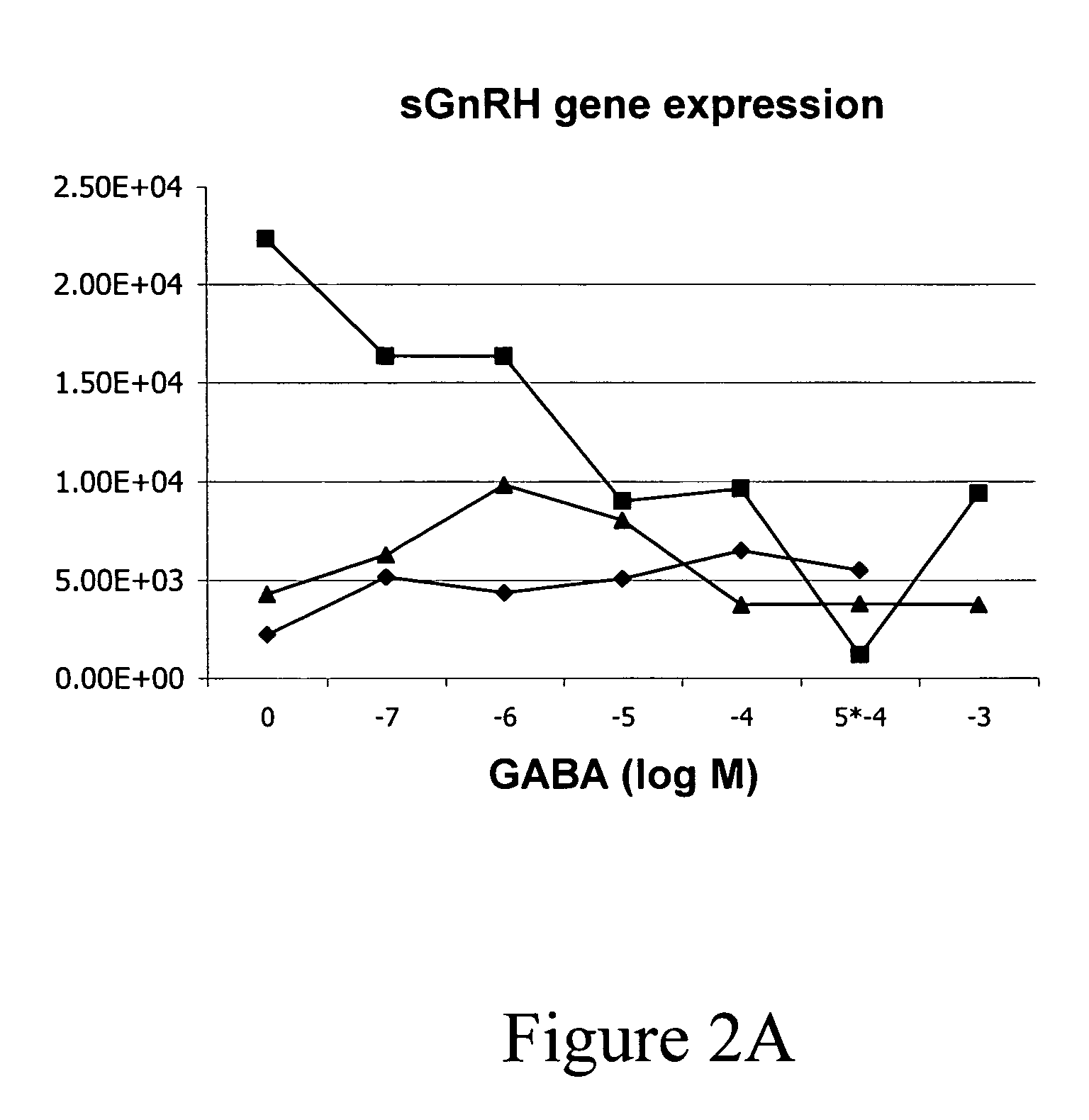Inducing sterility in fish by disrupting the development of the GnRH system
a technology of gnrh and induction of sterility in fish, which is applied in the field of inducing sterility in fish, can solve the problems of growing seafood deficit, alarming decline in commercial fisheries, and seafood harvests not increasing to meet the demand
- Summary
- Abstract
- Description
- Claims
- Application Information
AI Technical Summary
Benefits of technology
Problems solved by technology
Method used
Image
Examples
example 1
[0051] Fish embryos are obtained through natural and / or induced spawning of captive broodstocks (Zohar, et al., 1988: International patent #087982; Mylonas et al., 1996; Sullivan et al., 1997; Westerfield, 1993). Embryos are typically obtained from spawns of 3-4 females, pooled, and reared under appropriate species conditions. During exposure / treatment periods, embryos / larvae are kept in individual tanks / aquaria supplied with oxygen and water is changed daily. After treatments, larvae are moved to larval rearing systems and reared under standard conditions (e.g., for seabream, conditions such as those identified within Zohar et al., 2002 U.S. Pat. No. 6,443,097, the contents of which are incorporated by reference herein for all purposes.
General GABA Immersion Procedure
[0052] Larval fish are immersed for periods of 1-48 hours in a concentration ranging from 10−8 to 10−2 M of GABA, a GABA analog and / or a related GABA agonist or antagonist. Larval fish are treated using this process...
example 2
[0055] The data obtained from our studies demonstrated that treatment of larval fish with GABAergic compounds resulted in altered GnRH gene expression during early development, altered developmental migration of GnRH neurons, and subsequent inhibition of gonadal development. With the exception of our research, no studies to date have examined the control of developmental migration of GnRH neurons in fish species for the purpose of inducing permanent sterility.
Developmental Information on the GnRH System in Seabream and Other Perciform Fish
[0056] In gilthead seabream and other perciform species, 2 forms of GnRH [referred to respectively as salmon (s) GnRH and seabream (sb) GnRH] are expressed in the forebrain—the optic bulb / terminal nerve (OB / TN) GnRH neurons express sGnRH, and the preoptic area (POA) GnRH neurons express sbGnRH. As in all other vertebrates, midbrain GnRH neurons express chicken GnRH-II (cGnRH-II). PCR amplification of the 3 GnRH mRNAs at different stages of devel...
example 3
Effect of GABA on GnRH Neuronal Migration and Gonadal Development in Zebrafish
[0060] Zebrafish larvae were immersed in GABA (1 mM) or Muscimol (100 micromolar) at 5-8 days pf and 7-10 days pf. (Muscimol is a potent GABA agonist that acts specifically on GABAA receptor subtypes). Samples (n=12) were collected at 7, 9, 10, and 12 day pf for subsequent detection of GnRH neurons. The remaining fish were allowed to grow and, at 9 weeks, were sampled and processed for histological analysis of the gonads.
[0061] The migration of the GnRH neurons and gonadal development were clearly inhibited by the GABA-ergic treatments. Forebrain GnRH-expressing neurons in the zebrafish arise in the nasal placode and begin migration into the forebrain at 6-10 dpf. Parallel tracts of neurons in untreated larvae can be seen migrating posteriorly along the olfactory tracts in 12 day-old larvae (FIG. 3A). In fish treated at 7-10 dpf, however, GnRH expression is restricted to single paired clusters of neuron...
PUM
| Property | Measurement | Unit |
|---|---|---|
| Time | aaaaa | aaaaa |
| Time | aaaaa | aaaaa |
| Time | aaaaa | aaaaa |
Abstract
Description
Claims
Application Information
 Login to View More
Login to View More - R&D
- Intellectual Property
- Life Sciences
- Materials
- Tech Scout
- Unparalleled Data Quality
- Higher Quality Content
- 60% Fewer Hallucinations
Browse by: Latest US Patents, China's latest patents, Technical Efficacy Thesaurus, Application Domain, Technology Topic, Popular Technical Reports.
© 2025 PatSnap. All rights reserved.Legal|Privacy policy|Modern Slavery Act Transparency Statement|Sitemap|About US| Contact US: help@patsnap.com



